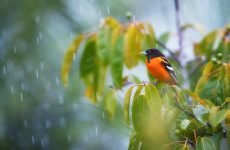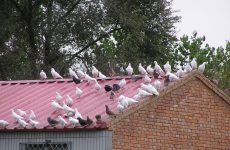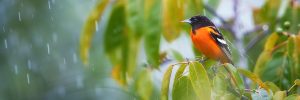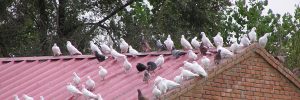
You may have seen how owls and other nocturnal birds sleep during the day, but where do other species go at night to sleep? Birds that rest during the night must find a warm and safe spot. There are various places where birds go at night.
Diurnal birds go to small crevices in trees, dense thickets, or water areas to sleep at night. Birds that sleep in water areas at night can pick up on water vibrations if predators are nearby. Nocturnal birds are active at night, and because they hunt, they don’t go to a specific place.
Different bird species show different behaviors at night. Some will settle down in more open areas, and others will find small, enclosed spaces. However, they all aim to find a safe and protected space to sleep at night.
Where Do Birds Go At Night?
Two main categories of birds determine where they go at night. Diurnal birds, which are most birds, are most active during the day, meaning they rest at night. During the night, these birds find somewhere to sleep. They must find a suitable shelter to rest and be safe for the night.
These diurnal birds are gulls, shorebirds, passerines (songbirds), woodpeckers, and bluebirds. At night they find a quiet place to stand or perch where they can sleep, and this is called roosting. Once the sun has started to set, birds begin to look for a place to rest for the night.
Sometimes you’ll also see birds taking a nap during the day. Sometimes if they do not get enough rest or the weather is poor, they may need some extra sleep. These are not nocturnal birds.
On the other hand, nocturnal birds do not sleep during the night, but hunt, forage and care for their young during this time. Some examples of these birds include owls, night herons, and nighthawks.
Nocturnal birds do not find a specific spot to go at night as they hunt for food or do other activities like caring for their young. Instead, they rest during the daytime.
Small And Protected Spots

Birds must be very smart about where they stop to rest for the night, as there are many predators around. Many birds go to places that serve as cavities or niches where they can be safe for the night, as it provides some shelter and enclosed space.
These cavities make it difficult for larger birds or other predators to come in and protect the birds from bad weather as well. Other roosting spots can be tree canopies or dense thickets where they are not very visible from the outside. These birds also look for small spots in dense foliage in vines, shrubs, and certain trees.
During stormy weather or heavy rains and wind, birds tend to hide in tree trunks, hollow trunks, or any space they can find that shields them from the weather.
Some birds that live in icy and snowy areas go to spots underneath dense bushes or coniferous trees where the snow can’t get in. These spots help them keep warm as well as out of view of predators.
Smaller birds especially tend to go to higher areas at night. They go to their cavities or nests, which are closer to the tree’s trunk, for extra protection. It is warmer and closer to the trunk, and any noise or vibrations from the branches will alert them to predators.
You might not expect so many small birds to fit in a tiny space, but they often do this to benefit from the warmth of each other. Many birds also like to go to unoccupied birdhouses at night. Some people have also found birds resting or sleeping in gutters and chimneys.
Another place where birds go at night is the top of the trees, where the branches are open and exposed. These are not protected from rain, cold, or other flying predators, but a spot where land predators definitely won’t be able to reach. A good example is a magpie who sleeps on tall trees in open areas.
Water And Island Areas

Other types of birds, like herons and flamingos, will sleep standing. They rest standing in water or on island areas. These birds are typically more exposed to predators and environmental factors but have warning systems.
Because they are standing in or surrounded by water, they can hear any splashes or water vibrations if a predator is nearby. These signals allow them enough time to wake up and escape. Some other birds that go to the water at night are geese, ducks, and waterfowl.
They float on the water when sleeping and use the same warning signals from the wave vibrations if predators are close.
You may have seen geese or ducks sleep in large flocks on the water. Gathering in large groups is another protection strategy.
Safety in numbers is a strategy that many breeds of birds use at night to stay safe. Blackbirds also roost together in huge flocks when they want to sleep. They even take turns watching out for predators during the night.
Migrating Birds Or Airbourne Birds

What about birds that are migrating long distances, especially over large seas? How can they sleep at night, they can’t roost when flying for days on end.
Well, scientists have discovered that birds can sleep while flying, but not as much as originally thought.
Frigate birds spend up to 10 days and nights flying continuously out at sea and never land on the water.
Birds can sleep with one eye and one-half of their brain sleeping, but some birds also switch all of their brains off and still fly. Birds on land can also do this.
However, they only sleep for a small percentage of the time when flying compared to when they are on land.
Do Birds Go To The Same Place Every Night?
Birds do not necessarily sleep in the exact same place every night. However, they tend to stay around the same spots and areas where they have been during the day or previous nights. Staying in the same place helps birds to secure their territory and feeding spots.
Therefore, many birds have regular places where they go at night. Birds who have built nests in particular areas with their young will return to those spots. The main goal of building a nest would be to incubate their eggs and have a safe and warm place for the young ones to hatch.
However, many birds do not build nests where they sleep, so they move around and go to different nighttime spots.
How Do Birds Sleep At Night?

Depending on the bird species, birds sleep in different ways at night. For instance, some birds, like ducks, float on the water, and others hang upside down like hummingbirds. Herons sleep standing on the ground or in the water.
Birds that like to rest in trees or branches need to maintain a firm grip while sleeping. Their legs and feet are built in such a way as to have a good grip on the branch, for example, almost locking them in place so they can sleep.
Smaller birds tend to sleep all tucked up in their small crevices or holes in the tree trunk. To stay warm, birds also fluff their feathers when sleeping at night. This fluffing of the feathers is an additional cover and protection from the cold.
Once birds are in their resting spot for the night, they are continuously waking up to stay alert. As there are so many dangers around, birds must be particularly aware of their surroundings and scientists have shown that bigger flocks awaken less than birds on their own.
Birds sleep in a specific way that allows them to be semi-alert at all times. They can still rest during the night but be alert enough to pick up on threats in their environment.
Final Thoughts
Diurnal birds go to small, safe, protected night spots to rest. These can include holes in tree trunks, open areas in dense shrubs, or in their nests in a tree.
Some other birds sleep floating in the water or standing in the water at night. However, nocturnal birds do not go to a specific place at night as they are mostly hunting.




